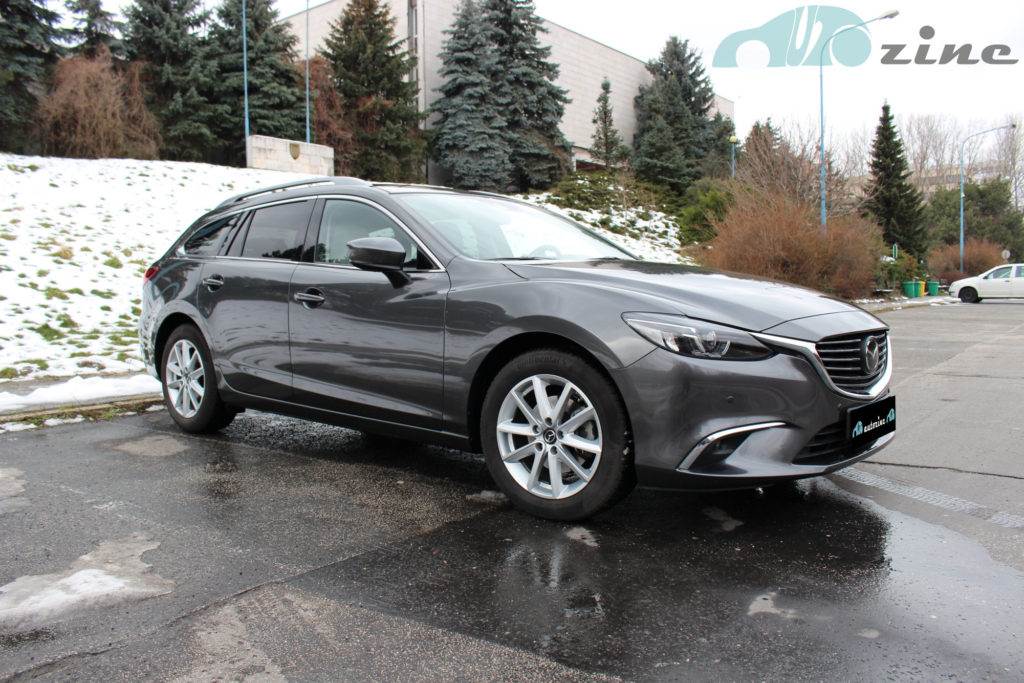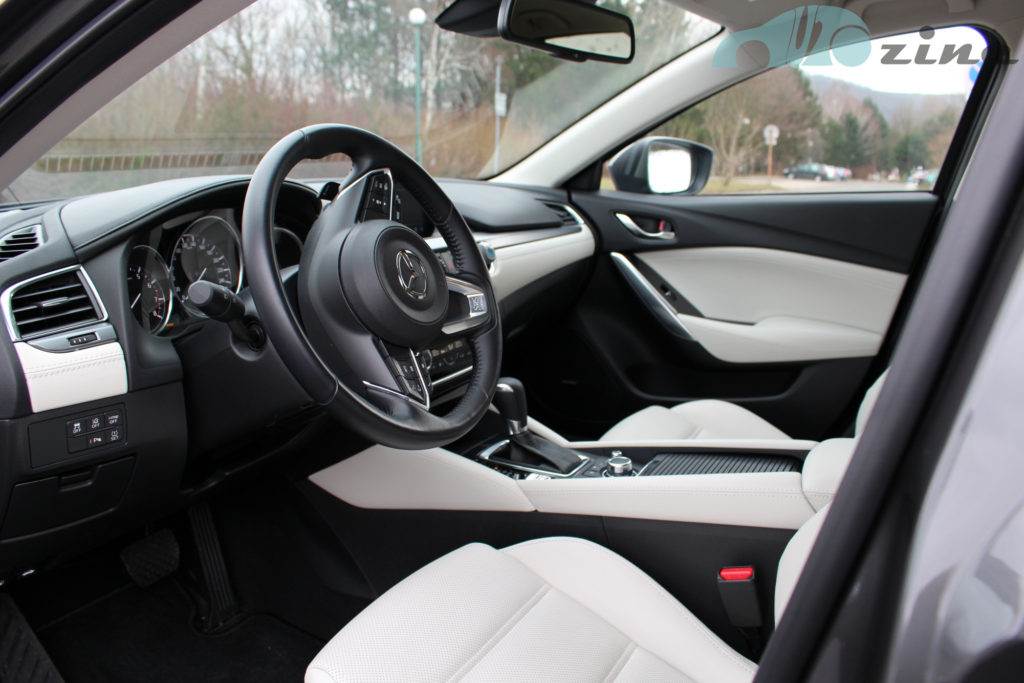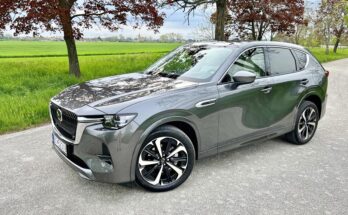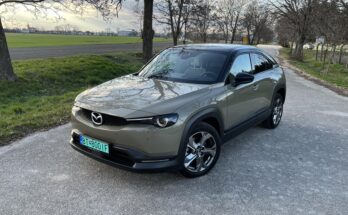" When you drive a Mazda, you are never alone. Car and driver in perfect harmony. As a rider on a horse – something we call “Jinba Ittai.” We believe that when unity is achieved, riding becomes fun. We do it our own way, because our cars are much more than just a way from point A to point B. Beauty by subtraction. A pure, intuitive relationship creates a bond that cannot be expressed in words. We are stronger together. We never drive alone. We ride together."
This quote is taken from Mazda's official website. Let's check if these statements are at least partially true. Today we will take the Mazda 6 for a test in the top-end Revolution Top equipment and with a 2.5 l gasoline engine.
Currently, it is the most powerful power unit that is supplied to the Mazda 6. With the next facelift in the summer of 2018, Mazda will also start offering a turbocharged version of this engine, which is based on the engine supplied as standard in the CX-9 overseas. Currently, its exact technical parameters are not yet known.
The question remains whether the Mazda 6 with this engine will also be available in Europe. The facelift will further include changes to the front and rear of the vehicle, a changed dashboard, instrument panel, new trims, a new 2.5 naturally aspirated petrol engine with low-load deactivation from the CX-5 model, etc.
But let's return to the tested vehicle. Revolution Top represents the highest equipment, which can only be extended with white leather (standard is black), sunroof, navigation and metallic. We have available a station wagon model with navigation, white leather and " premium " Machine Gray metallic . According to the official price list, the price for this model, including surcharges, is an acceptable EUR 34,775.
The Mazda 6 of this model series has been on the market since 2012 and has undergone two facelifts so far. The first year in 2015 involved a radical change in the interior, the second in 2017 was more about technical changes and fine-tuning of details.
Exterior
Despite the relatively long period of sale of this model, it still hasn't lost any of its appeal and I dare to consider it one of the most beautiful station wagons of current production. It requires 19 ” wheels, which is the current trend for many car brands. . By the way, the supplied dark gray matte 19” wheels look beautiful. However, we have a Mazda shod on 17" wheels with Continental winter tires, which detracts a bit from the car's beauty.
The last facelift did not change anything on the exterior, the six still has a long front hood, narrow headlights, a prominent radiator grille, small hoods, several chrome accessories on the front fascia, around the windows and on the rear. The gray color suits the car extremely well and gives the car a slightly luxurious touch. At the same time, it is impractical because it can get dirty quite quickly and requires frequent washing.
Design is always a subjective matter and you either like the car or you don't. The shapes of Mazda's new models are overwhelmingly met with positive reactions, and this is of course reflected in the global upward trend in sales of individual models.
Interior
The Mazda 6 station wagon represents the spatial average of the middle class. The car is wide enough and provides very comfortable conditions for four passengers. Paradoxically, due to the longer wheelbase, the sedan offers more room for the knees in the rear seats, but naturally less for the head of the rear passengers.
The tested piece with white premium leather evokes a feeling of luxury, and the color contrast with black plastics looks interesting. On the other hand, white leather is impractical and requires increased care. The seats are firmer, with average seat length and decent lateral support. Overall, they are comfortable and provide good back support even during longer journeys. The front passenger lacks an adjustable lumbar support and has fewer electric seat adjustment options. I would welcome the possibility of adjusting the seats to a lower position. If the driver is over 190 cm tall, his head will already touch the roof upholstery.
The instrument panel has been slightly changed after the last facelift and contains a color display showing on-board computer data such as average and immediate consumption, range, compass, coolant temperature, safety assistant data and warnings, etc. Switching between individual data is done with a button on the steering wheel. Someone might be bothered by setting up a list of data and not being able to change it. For example simultaneous display of coolant temperature and instantaneous consumption cannot be achieved.
The center console is quite wide, but offers a padded footrest for the driver's right leg. The panel consists of controlling the air conditioning, heating of the front seats and the steering wheel with slowly "obsolete" classic buttons and circular controls, which, in my opinion, is still a more acceptable solution than controlling these functions using a touch screen, at least from the point of view of safety.
Infotainment has not changed since the launch of the last Mazda 3 in 2013. It already has relatively outdated graphics, is not the fastest and does not have the widespread support of Android Auto and Apple Car anymore. Mazda promises it for 2018. Control is intuitive and offers the possibility of control using a rotary control between the seats as well as a touch screen when the vehicle is stopped. I didn't have a fundamental problem with the navigation, but I would have welcomed the possibility to adjust the volume, especially for voice guidance and warnings (e.g. for the presence of radars and changes in the traffic situation). Mazda also offers the possibility of obtaining detailed traffic information from the Here maps source using a mobile phone hotspot. This service is not yet available in Slovakia. Map updates are free for 3 years after the purchase of the vehicle and take place twice a year.
The space between the seats is filled by a rotary infotainment control with quick selection buttons, an electronic handbrake with the missing Auto Hold function and an automatic transmission mode switch. The armrest is located relatively far back and shorter people will not use it.
Storage spaces are decent, the box in front of the passenger is upholstered, but not air-conditioned. The space under the armrest is spacious enough, and the space for glasses or bottles can be covered with a tasteful sliding roller blind. The space in front of the automatic transmission selector can also be used for a larger mobile phone. 2 USB inputs, 2 power sockets are currently standard.
Another electric outlet is in the luggage compartment, which has an average of 522 liters (1648 liters when the rear seats are folded down), but a regular shape, a double bottom and an interesting roller blind, which is anchored on the fifth door. Levers for folding the rear seats located on the sides of the luggage compartment. Two plastic hooks and four metal eyes are the only option for securing luggage. Other manufacturers provide more options.
Driving, consumption
Let's ride. After starting, the idle speed remains relatively high for a while, which is characteristic of Skyactiv engines. After engaging D, the revolutions drop to the normal level immediately. The first three gears are short and provide the car with significant dynamics, which must be taken into account especially during a sharp start in the city. The other stages are already longer, which helps achieve low consumption at higher speeds. At highway 130, the crankshaft rotates 2500 times per minute.
The engine has a volume of 2488 cm3, an output of 141 kW at 5700 revolutions, a torque of 256Nm at 3250 revolutions and a high compression ratio of 13:1. By the standards of atmospheric engines, it is flexible from low revs, but from 4000 it can fully reveal its volume and power. A very pleasant linear gradation of power up to the red range of revolutions combined with a thicker and especially natural sound of the engine can be addictive. The engine is exceptionally quiet and vibration-free at low speeds. The 6-speed automatic keeps the revs relatively low in normal mode, around 1200 revs depending on the speed. Nevertheless, it does not protest, does not rumble and does not vibrate, so it does not matter in principle. A hindrance can be that when power is suddenly needed, it takes a while for the transmission to shift, revs to pick up, and the car to accelerate. This problem is eliminated by activating the sports mode, which keeps the revolutions at a higher level and the response of the engine and transmission is lightning fast. For this reason, I would welcome the possibility of activating the sports mode in a more accessible place (e.g. on the steering wheel).
The steering wheel is the right size, but I would appreciate a slightly thicker rim. The power steering is set as a compromise to a bit forceful, you can feel hints of feedback from the front wheels from the steering during driving, which is almost an exception these days.
The self-made automatic gearbox shifts almost imperceptibly and with feeling. During gentle acceleration, when engaging the second gear, it sometimes waits needlessly and when shifting to a higher gear, but that is probably the only thing I would criticize it for. When more gas is added, it reacts reasonably quickly, using the maximum possible revolutions close to the red zone. The transmission can sense what you want from it based on the pressure on the gas pedal, adapts the logic of shifting gears to it and does not try to maintain low consumption at all costs. When changing gears with the levers under the steering wheel, the transmission will hold the engaged gear for a while before returning to automatic mode.
When switching to manual gear mode, the transmission serves to its credit that, even in the case of recklessly revving the engine into the red speed range, it does not shift itself immediately, but by default hits the limiter as in the case of a manual transmission.
The driving characteristics of the Mazda 6 were discussed in many tests and were rated highly positively in the overwhelming majority. When the steering wheel is turned sharply, the Mazda noticeably leans on the outer front wheel and turns in the desired direction. If you overdo it with speed, the incoming understeer will show very soon and the driver has enough time to react. A gentle reduction of the gas can return the car to the desired direction even without the help of the stabilization system. It generally does not intervene too soon and will give the driver the opportunity to have fun with the car safely. As in one of the few middle-class cars, it can be turned off completely.
When making a sharper change of direction at lower speeds, it is necessary to pay attention to the engaged higher gear (as mentioned above), which does not allow you to pass the turn under the gas. Then it is necessary to help the engine by manually downshifting before entering the turn.
The chassis is pleasantly stiff, the car does not lean too much, but it is also comfortable on 19" wheels. When driving on a poor-quality road, no unpleasant shocks are transmitted to the vehicle, the stiffness of the chassis is felt only on broken asphalt full of transverse unevenness.
The test route led from Bratislava to Vienna and back. The road to Vienna takes the old road B9 through the town of Hainburg to the village of Fischamend, then the A4 highway, the S1 expressway. I traveled the whole way to Bratislava on the highway. Observing speed limits + 10%, I achieved a consumption of 7.1 on the route Bratislava – Vienna and 7.5 l/100 on the way back. The traffic was adequate for a normal working day, to which I adapted my driving style without striving for low consumption.
Equipment
The tested vehicle pampers its passengers with full equipment and a number of driving assistants. I will not name all the equipment elements, I will focus only on those that caught my attention or on which I have comments.
I will first mention the head-up display, which does not project data onto the windshield, but onto an auxiliary plastic glass. It has pleasant graphics and displays all the necessary information in the driver's field of vision, such as speed, adaptive cruise control data, navigation instructions, speed limit supported by the ability to read road signs.
The heating of the steering wheel is felt after half a minute after turning it on on its sides, after starting the car in the morning I liked to use it together with the heating of the seat, which takes a little longer to warm up.
The adaptive cruise control works from 30 km/h, I used it almost everywhere except the city and did not encounter a single problem. Its only disadvantage is the absence of a driving assistant in a convoy, which causes the cruise control to turn off when slowing down below 30 km/h. The driver is informed about this by a message on the head-up display.
The lane keeping assistant works below average and only reacts correctly to the first approach to the line on the road.
The blind spot monitoring system works as an example with a minimum of false alerts.
The rear camera is placed unhappily and tends to get dirty quickly.
The LED lights with the oncoming car shading system works without any problems, but it is not among the most modern due to the small number of LED segments (4 in one headlight).
What I have to highlight is the finally satisfactory soundproofing of the interior from aerodynamic noise, which was missing from the versions before the last facelift.
Maintenance
The service takes place every 20,000 km or once a year. Prices in authorized service centers range between EUR 200-350, depending on the location of the service (Bratislava is naturally the most expensive) and the number of checked items and/or changed fillings of operating fluids.
Verdict
The Mazda 6 is not one of the best-selling mid-range vehicles mainly because of weak support for fleet sales from the importer, persistent distrust of Japanese brands and the impossibility of configuring individual equipment items. The service network within Slovakia is relatively poor, which also does not benefit the sales figures.
Nevertheless, this is a car that deserves attention. The manufacturer tries to constantly improve this model and eliminate its shortcomings. Its prices, compared to similar models of competing brands, are among the more favorable, especially in higher equipment. Reliability is globally above average, especially with atmospheric gasoline engines.
Design, driving characteristics, innovations and unusual engines rank the Mazda 6 among the top in the non-premium middle class. Anyone interested in a mid-class family station wagon with a relatively powerful gasoline engine should definitely not miss it.





